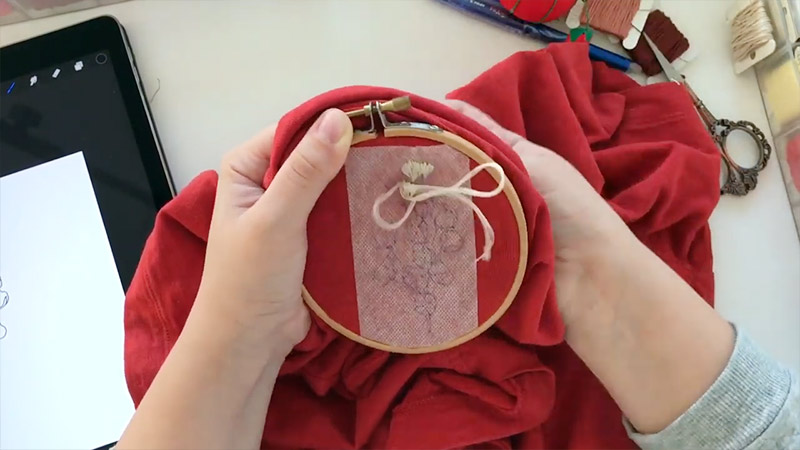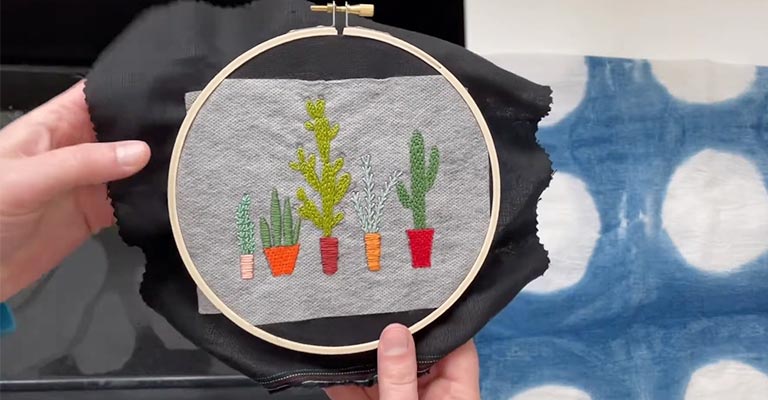Embroidery paper, a remarkable innovation in the realm of textile artistry, serves as a vital companion to both hand and machine embroiderers.
This specialized material, also known as a water-soluble or dissolvable stabilizer, has garnered attention for its remarkable ability to dissolve in water, leaving behind the intricately stitched designs it once supported.
The magic lies in its composition, typically crafted from water-soluble polymers, like polyvinyl alcohol, carefully engineered to break down upon contact with moisture.
This introduction explores the fascinating world of embroidery paper and its transformative role in simplifying the embroidery process, preserving the integrity of fabrics, and ultimately ensuring the creation of stunning, residue-free embroidered works of art.

Does Embroidery Paper Dissolve?
Embroidery paper, often referred to as water-soluble or dissolvable stabilizer, is a specialized type of paper used in machine and hand embroidery to provide support and stability to the fabric during the stitching process.
This paper is designed to dissolve in water, leaving behind the embroidered design while eliminating the need to tear or cut away excess stabilizer. It is a versatile tool that simplifies the embroidery process and enhances the final results.
Here’s how embroidery paper works and some key points to consider:
Composition
Embroidery paper is typically made from a water-soluble material, such as polyvinyl alcohol (PVA).
PVA is a synthetic polymer that dissolves when it comes into contact with water, making it ideal for use in embroidery.
Stabilization
Embroidery paper is used to stabilize the fabric during the embroidery process. It is placed beneath the fabric or on top of it, depending on the specific project and the type of machine or hand embroidery being used. This added stability prevents the fabric from puckering or stretching during stitching.
Temporary Support
The paper provides temporary support, which is especially useful when working with delicate or stretchy fabrics like organza, tulle, or knits.
It keeps the fabric in place without the need for permanent backing, which can be visible on the finished design.
Dissolvability
The key feature of embroidery paper is its ability to dissolve in water. After the embroidery is complete, the paper can be soaked in water, either by spraying it with a mist of water or immersing it in a basin.
The PVA material breaks down, leaving only the embroidered design behind. This eliminates the need to manually cut or tear away excess stabilizer, saving time and ensuring a cleaner finish.
Use in Free-standing Embroidery
Embroidery paper is also commonly used in creating free-standing lace and 3D embroidery designs.
In these cases, the paper acts as a foundation for the design, and once the embroidery is complete, the paper dissolves, leaving a lace-like or three-dimensional structure.
Versatility
Embroidery paper is available in various forms, including rolls, sheets, and pre-cut shapes, making it adaptable to different embroidery projects. It can be used with both machine and hand embroidery, depending on the specific requirements.
Care and Handling
It’s important to follow the manufacturer’s instructions for using and dissolving embroidery paper. Proper care ensures that the paper dissolves completely, leaving no residue on the fabric.
How to Dissolve Embroidery Paper?

Dissolving embroidery paper is a crucial step in the embroidery process, as it ensures that your beautifully stitched design remains free from any residual stabilizer.
Here’s a step-by-step guide on how to dissolve embroidery paper effectively:
Materials You’ll Need:
- Embroidery with stabilizer attached
- A basin or container of clean, room-temperature water
- Gentle detergent (optional)
- Soft brush (optional)
- Towels or paper towels
Step-by-Step Dissolving Process:
Prepare Your Embroidery
Make sure your embroidery project is finished, and the embroidery paper is still intact and attached to the fabric. This ensures that the design remains in its intended position.
Fill a Basin with Water
Take a clean container or basin, and fill it with room-temperature water. Avoid using hot water, as it can compromise the stability of the embroidery paper.
Immerse Your Embroidery
Gently and carefully lower your embroidered piece, including the stabilizer, into the basin of water. It’s essential to ensure that the entire design is submerged. Submerging the fabric allows the water to penetrate and initiate the dissolving process evenly.
Wait for Dissolution
Allow the embroidery paper to sit in the water. The time required for complete dissolution can vary depending on the brand and type of embroidery paper, but it typically takes a few minutes. Patience is key; avoid the temptation to rush the process.
Agitate Gently
If you notice that the paper isn’t dissolving as quickly as you’d like, you can gently agitate the water by lightly swirling it or using a soft brush to help expedite the process. Be cautious not to damage the embroidery itself while doing this.
Check for Dissolution
Carefully inspect the embroidery. The paper should start to break down, becoming more transparent as it dissolves.
You can gently touch it to see if it’s soft and easily separates from the fabric. If it still feels solid, give it a bit more time in the water.
Rinse and Repeat
Once you’re confident that the embroidery paper has dissolved, remove your embroidery from the water.
If you see any remnants of the stabilizer, rinse the fabric under running water to ensure all traces of the dissolved paper are gone. Ensure thorough rinsing to prevent any leftover residue.
Dry Your Embroidery
Gently pat your embroidery with a clean towel or paper towel to remove excess water. Lay it flat on a clean, dry surface to air dry completely. Avoid wringing or stretching the fabric, as it may distort the design.
Optional Washing
If your embroidery project requires washing to remove any remaining stabilizer residue or other contaminants, do so with a gentle detergent, following the fabric’s care instructions. Rinse the embroidery thoroughly and dry it again after washing.
Finishing Touches
Once your embroidery is completely dry, you can proceed with any finishing touches your project may require.
This could include framing, ironing (with a pressing cloth), or any other steps needed to present your beautifully completed embroidery.
FAQS
Can embroidery paper dissolve in cold water, or does it require warm water for effective dissolution?
The majority of embroidery papers dissolve effectively in room-temperature or cold water.
Using warm or hot water is generally not recommended, as it can affect the stability of the paper and the quality of the embroidery.
Is it possible to speed up the dissolution process of embroidery paper?
Yes, you can gently agitate the water or use a soft brush to help expedite the dissolving process. Be cautious not to damage the embroidered design while doing so.
Can embroidery paper be used on all types of fabric?
Embroidery paper is compatible with a wide range of fabrics, but the choice of fabric and embroidery paper should complement each other.
Delicate or sheer fabrics, like silk and organza, may benefit the most from this stabilizer.
What if I can’t find a water-soluble stabilizer specific to my machine’s brand?
You can use a universal water-soluble stabilizer that is compatible with most embroidery machines. However, always test a small piece of it on your fabric to ensure compatibility before starting your project.
Can I reuse embroidery paper for multiple projects?
Generally, embroidery paper is designed for single-use applications. Once it dissolves, it loses its stabilizing properties.
It’s recommended to use a fresh sheet of embroidery paper for each new embroidery project to ensure the best results.
To Recap
The remarkable capability of embroidery paper to dissolve in water has revolutionized the art of embroidery.
This versatile tool provides crucial support during the stitching process, preserving delicate fabrics and intricate designs, while its dissolvable nature simplifies the finishing touches.
Its use extends from machine to hand embroidery, offering a solution to a wide array of projects.
Understanding the proper dissolving techniques and materials ensures that the process is seamless, leaving behind a clean and professional-looking embroidered masterpiece.
The dissolution of embroidery paper is a testament to the ever-evolving world of textile art, where innovation meets tradition to produce awe-inspiring creations, free from the constraints of excess stabilizer.
Leave a Reply